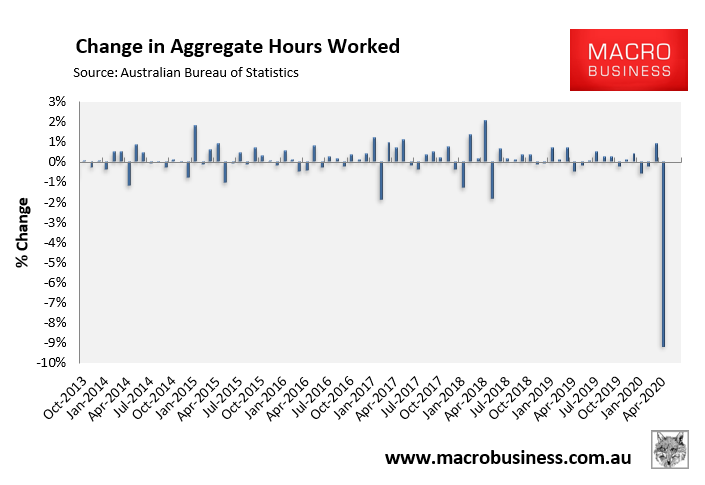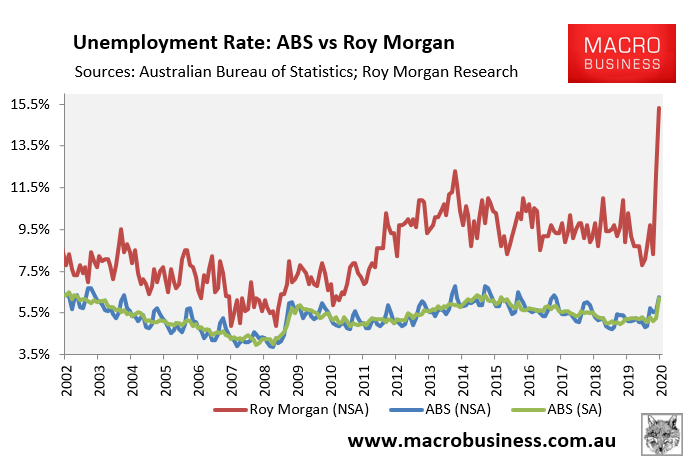In the wake of last week’s absurd 6.2% unemployment rate for April, the Australian Bureau of Statistics (ABS) has released an explainer on why it has included those on JobKeeper as employed:
JobKeeper payments will provide an estimated $130 billion of support from the Australian Government to eligible employers. The payments will be made by the Australian Taxation Office directly to eligible employers who will be directly responsible for ensuring that eligible employees receive a wage of at least $1,500 per fortnight for a maximum period of six months commencing on 30 March 2020.
Payments by eligible employers will be made through their payroll to eligible employees, within the conditions of their existing employer-employee relationships. All payments to employees will be reported through the tax system using Single Touch Payroll. Employees’ income tax liabilities will include JobKeeper payments.
Referring to international manuals and guidance, the Australian Bureau of Statistics (ABS), has considered how JobKeeper payments will be treated in ABS official economic statistics. The ABS has determined that JobKeeper payments will:
be classified as an ‘other subsidies on production’ paid from government to eligible employers
employees whose employers are receiving the JobKeeper payment will be classified as employed and in receipt of a wage.Rationale
In accordance with the 2008 System of National Accounts (SNA08) and additional international guidance from the International Monetary Fund (IMF) and International Labour Organisation (ILO), the Australian Bureau of Statistics considered two options for classifying and treating JobKeeper payments in ABS economic accounts:
1. as an other subsidies on production (SNA08 7.106)
2. as a social benefit (SNA08, 8.17).Starting from a production perspective, production is “an activity, carried out under the responsibility, control and management of an institutional unit, that uses inputs of labour, capital, and goods and services to produce outputs of goods and services” (SNA08, para 6.2).
The labour element of production is supplied by employees or self-employed persons (SNA08, 7.29).
Employed persons are involved in production and part of the labour force, which ‘consists of those who are actively prepared to make their labour available during any particular reference period for producing goods and services within the production boundary’ (SNA08, 19.17).
Some employers receiving JobKeeper payments will be actively involved in production and some will not. When an employer continues to pay someone, even if working zero hours, they are regarded as having a formal job attachment and employed as receiving a wage or salary (SNA08, 19.23).
This then leads to the decision to treat JobKeeper payments as an ‘other subsidies on production’. It should be noted that this will be kept under review as further information becomes available on JobKeeper payments.
‘Other subsidies on production’ consist of subsidies except subsidies on products that resident enterprises may receive as a consequence of engaging in production. (a) subsidies on payroll or workforce: these consist of subsidies payable on the total wage or salary bill, or total work force, or on the employment of particular types of persons such as physically handicapped persons or persons who have been unemployed for long periods (SNA08, 7.106).
Employers in receipt of JobKeeper will be receiving an ‘other subsidy on production’. This will be passed onto eligible employees as a salary or wage.
Salaries or wages will continue to be classified as either compensation of employees or gross mixed income for e.g. self-employed persons. These payments demonstrate a formal job attachment.
In contrast, social benefits are ‘received by household intended to provide for the needs that arise from certain events or circumstances’, for example, sickness, unemployment, retirement, housing, education or family circumstances. Social benefits may be provided under social insurance schemes or by social assistance (SNA08, 8.17).
Blah, blah, blah. The fact of the matter is that Australia’s official unemployment rate has never been more irrelevant and useless as an economic indicator.
Commentators should instead us alternative indicators, like hours worked:

Alongside alternative measures, like Roy Morgan’s unemployment estimate:


